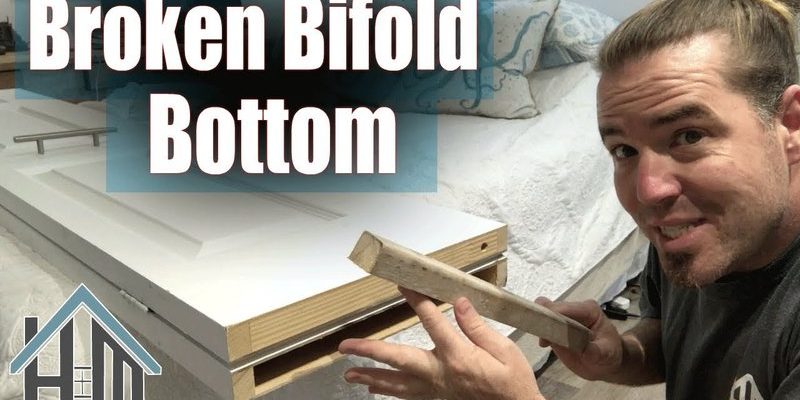
A bi-fold door is designed for convenience, allowing you to save space while adding a touch of elegance to any room. That makes it all the more frustrating when a catch—essentially the small piece that keeps the door securely closed—fails. It might be that the lip of the catch has cracked, or perhaps the spring mechanism has lost its spring. Whatever the cause, this guide will walk you through the steps to get that bi-fold door functioning like new again.
Understanding Your Bi-Fold Door and Its Components
Before diving into the repair, it’s helpful to understand what a bi-fold door is made of. Typically, these doors consist of two or more panels that fold against themselves along a track. The catch plays a crucial role, acting as a latch that holds the doors together when they are closed. The types of catches can vary based on the door’s design and the manufacturer, making it essential to identify what you’re working with.
In general, you’ll find two common types of catches on bi-fold doors:
- Spring-Loaded Catches: These are often found in lighter, more modern designs. They use a spring mechanism to keep the door aligned and locked in place.
- Deadbolt Catches: This type offers a more robust option, often found in heavier doors for added security.
Keeping your door’s catch in good condition is vital. Not only does it improve functionality, but it also ensures your door looks neat and tidy when closed. A broken catch can lead to doors that don’t stay shut or, worse, become misaligned, which could cause damage over time.
Gathering Tools and Materials
Now that you know what you’re dealing with, it’s time to get your tools together. Don’t worry; you won’t need anything too fancy! Here’s a quick list of what you’ll need to repair a broken catch on a bi-fold door:
- Screwdriver: A Phillips or flathead, depending on your door’s screws.
- Replacement catch: Make sure it matches your door’s specific design.
- Level: To ensure everything aligns properly after repair.
- Pliers: Handy for tightening or adjusting fittings.
Having all your tools ready before you start can save a lot of time and frustration. You don’t want to be halfway through repairing your door and realize you’re missing a simple screwdriver!
Steps to Repair the Broken Catch
Once you’ve got your tools, it’s time to dive into the repair work. Here’s a step-by-step guide to help you through the process:
1. Remove the Old Catch
First, close the bi-fold door to get a good look at the catch. Using your screwdriver, remove the screws holding the catch in place. Remember to keep these screws in a safe spot; you’ll need them later.
2. Position the New Catch
Take your replacement catch and line it up where the old one was. Before screwing it in, ensure it fits snugly. This is where your level comes in handy. Place it against the catch to check for alignment. If it’s off, you may need to adjust the positioning slightly.
3. Secure the New Catch
Once everything looks good, use your screwdriver to secure the new catch in place. Don’t overtighten; this can strip the screws and cause more problems down the line. Just make sure it’s snug.
4. Test the Door Functionality
After securing the catch, gently open and close the door. You want to make sure it catches properly when closed and opens smoothly. If the door doesn’t align correctly, you might need to tweak the catch slightly.
Common Problems and Troubleshooting
Even after installation, you might run into some hiccups. Here are a few common issues and how to troubleshoot them:
- Door Misalignment: If the door doesn’t close properly, check the alignment of the catch. You may need to reposition it slightly.
- Catch Doesn’t Stay Engaged: A spring-loaded catch can lose its tension over time. If that’s the case, consider replacing the entire catch rather than just repairing it.
- Rust or Corrosion: If the catch looks rusty, it might be time to replace it. A rusty catch can hinder functionality and may break again soon.
If you encounter any of these problems, don’t be discouraged! Often, a quick adjustment or a more robust replacement can save the day.
Choosing the Right Replacement Catch
When it comes time to buy a replacement catch, you’ve got options. Consider the following factors to make the best choice:
- Material: Catches are available in plastic, metal, and other materials. Metal options are usually more durable.
- Size: Measure your old catch before purchasing to ensure a good fit.
- Brand Compatibility: If you have a specific door brand, check if they offer a replacement catch designed for your model.
Taking a little extra time to choose the right catch can save you from future headaches.
Why Regular Maintenance Matters
Once you’ve repaired your bi-fold door, it’s crucial to maintain it properly. Regular maintenance can extend the life of your door and its components. Here are a few simple tips to keep in mind:
- Clean the Tracks: Dust and debris can affect how smoothly your door operates. Give the tracks a quick clean every few months.
- Lubricate Moving Parts: A little spray lubricant on hinges and catches can work wonders in keeping everything functioning well.
- Regular Inspections: Every so often, check the catches and hinges for signs of wear and tear. Catch issues can sneak up on you!
By keeping an eye on things, you can prevent future catch failures and ensure your bi-fold door operates smoothly for years to come.
Repairing a broken catch on a bi-fold door might feel intimidating at first, but it’s really just a matter of understanding the components and taking things step by step. With the right tools and a bit of patience, you can tackle this repair without calling in a pro. And once you’re done, you’ll not only have the satisfaction of a job well done, but you’ll also enjoy your fully functional door once again.
So, the next time that catch gives way, remember—you’ve got the skills to fix it! Just take your time, follow the steps, and soon enough, your bi-fold door will be as good as new.
